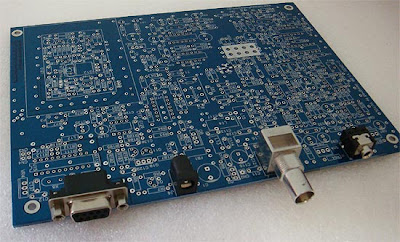 On Sunday I was working on my little DaVinci QRSS transmitter. I had it on, happily generating FSK on 30 meters. Then all of a sudden I noticed that power out had dropped to zero. I suspected a blown final transistor -- this was before the installation of my elegant Altoids smoke-stack heat sink, and the little 2N3904 I was using in the final was getting quite hot (it runs Class A). Almost instinctively, I turned to the ON5EX grabber. The image from Johan's receive system captured the final moment of that transistor. See that bright spot where the square wave ends? That's when the transistor blew. I tested the 2N3904 out of circuit: the base-collector junction is now completely open (no current in either direction). The death of this transistor may also have been related to the intermittently bad 4700 ohm resistor in the bias circuit. The 2n3904 has been replaced by a more robust 2N3053 sent to me by AA1TJ. It is protected by the Altoids smoke-stack heat sink (scroll down for schematics and an image).
On Sunday I was working on my little DaVinci QRSS transmitter. I had it on, happily generating FSK on 30 meters. Then all of a sudden I noticed that power out had dropped to zero. I suspected a blown final transistor -- this was before the installation of my elegant Altoids smoke-stack heat sink, and the little 2N3904 I was using in the final was getting quite hot (it runs Class A). Almost instinctively, I turned to the ON5EX grabber. The image from Johan's receive system captured the final moment of that transistor. See that bright spot where the square wave ends? That's when the transistor blew. I tested the 2N3904 out of circuit: the base-collector junction is now completely open (no current in either direction). The death of this transistor may also have been related to the intermittently bad 4700 ohm resistor in the bias circuit. The 2n3904 has been replaced by a more robust 2N3053 sent to me by AA1TJ. It is protected by the Altoids smoke-stack heat sink (scroll down for schematics and an image).Hope everyone is having fun at Dayton. I caught G3RJV's talk yesterday via streaming video. As always, inspiring stuff! And I really liked a word he used: socketry. You know, "the PC board, and the box will all the associated SOCKETRY."












































